A PAT Solution for Automated Mill Control
The authors describe the implementation of an on-line particle-size analyzer on an active pharmaceutical ingredient milling operation at a commercial site.
Quality by design (QbD) encourages the pharmaceutical industry to gain a better understanding of the sources of risk and variability inherent in product manufacture. Effective process analytical technology (PAT) plays an important role in QbD because it enables efficient information gathering at the development stage and offers opportunities for improved process control. An optimal PAT solution provides reliable and timely measurement of a critical variable in a cost-effective manner.
The particle-size distribution of an active pharmaceutical ingredient (API) is often a critical quality attribute that can impact not only drug-product performance, dissolution, and content uniformity, but also the manufacturability of drug product by such issues as flowability and segregation. An integral part of new product development, therefore, is to determine the appropriate range for API particle-size distribution based on drug-product performance. Typically, API particle size is controlled within this range through the milling operation.
Batch API milling with off-line analysis
Batch milling is used widely during API manufacturing to reduce particle size to an acceptable range to meet the defined specification. Figure 1 shows a comminutor mill setup, commonly used in API manufacturing for a milling application.
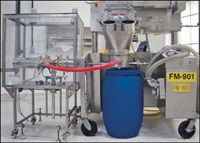
Figure 1: Image of a comminutor mill with the Insitec on-line particle-size analyzer installed. (FIGURES ARE COURTESY OF AUTHORS)
In this mill, material entering via the feed throat is broken up by the rotating blades, which apply a cutting and impacting action. Particles within a defined size range exit via the screen, which retains oversized material in the mill for further comminution. Blade profile and screen specification both influence the size of the exiting particles, but from an operational standpoint, rotor speed is the principal control variable.
With only off-line analysis in place, controlling the API particle size within an acceptable range is an iterative process. Initially, a small quantity of material (1 to 5 kg, for example) is milled at a speed selected on the basis of historical experience. Measuring the particle size of the resulting material in the laboratory determines acceptability. If the milled powder meets the specification for the product, the remainder of the batch is processed under these conditions. If not, mill speed is altered, and another small quantity of material is milled and tested. This process continues until acceptable conditions are established. Because of batch-to-batch variability, this procedure is repeated for every batch in a campaign.
This iterative process is time consuming and wastes material. Equally important, the particle size of the milled powder can be quite variable. The process is fixed rather than responsive to the properties of the feed, so, for example, if the feed batch is segregated and/or the test sample is not truly representative, there is an impact on final-product particle-size distribution. Final testing only verifies that the average properties of the batch are acceptable and reveals no information about manufacturing consistency. It is therefore common to produce material with a relatively broad particle-size distribution, which maybe detrimental to steady downstream operation.
Real-time particle-size measurement
To improve the efficiency of mill operation, and to deliver more consistent milled particle sizes, an Insitec online particle-size analyzer (Insitec, Malvern Instruments, Worcestershire, UK) was identified as a possible solution for continuous milling monitoring and control. This system employs the technique of laser diffraction, a well-established and robust method, and is specifically designed for easy integration into the manufacturing process. Unlike some PAT instruments that are based on modifications from a laboratory unit platform, and which tend to be sensitive to the manufacturing environment, the Insitec was designed to be used on the shop floor. The rugged integrity of the system is well proven across a diverse range of industries. It is being applied increasingly in the pharmaceutical industry as companies implement PAT.
A pilot-plant trial was performed to demonstrate the feasibility of using the Insitec system on an API milling operation. A mobile analyzer was installed on-line at the exit of a comminutor mill. With this on-line setup, material is continuously aspirated from the process stream, through a sample flute, using a venturi eductor, which disperses sample into the measurement zone and is returned to the process line after analysis. The system has no moving parts and operates 24/7 with very little manual intervention. The particle-size distribution is measured continuously and reported with a user-defined frequency (once every 0.25–60 s).
Figure 2 shows particle-size distributions measured during the pilot-plant trial at low, medium, and high mill speeds. The results of the pilot trial showed the potential of on-line particle-size analysis, demonstrating the ability of the Insitec to track process variation in real time and produce results that can be used in process and quality control.
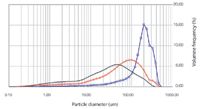
Figure 2: Using the Insitec on-line particle size analyzer to detect changes in particle-size distribution resulting from changes in mill speed, where the blue, red, and black lines show the particle size produced at low, medium, and high mill speeds, respectively.
Knowledge gained during the pilot-plant trial helped streamline the implementation of on-line particle-size analysis at the commercial manufacturing site. Here, a spool piece was fabricated to accommodate the probe for the analyzer and to interface with the standard product containers used to collect powder exiting the mill (see Figures 1 and 3).

Figure 3: Spool piece accommodating the sampling probe for the on-line analyzer and directing sample return toward product collection.
Since sampling bias and incorrect dispersion are the main causes of measurement error, both for laboratory and process analysis, experimental work was carried out to optimize the process interface. To ensure sampling was representative, particle size was measured at different points across the diameter of the exit line to detect any segregation and determine a suitable position for the sampling probe. Measuring particle size as a function of gas flow through the eductor generated a particle-size–flow-rate plot that was used to determine suitable conditions for dispersion (see Figure 4).
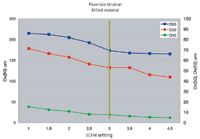
Figure 4: Effect of nitrogen flow through the eductor on measured particle size (flow/size titration) with Dv50 value produced using established off-line measurement technique superimposed (yellow bar). SCFM is standard ft3/min.
The results of these investigations showed that a single-holed probe extracting sample from the center of the spool piece produces the most representative sample. The size of the sampling hole was also optimized to ensure an adequate scattering signal was obtained. A dispersion flow rate of 3 standard ft3/min breaks up any agglomerates without causing primary particle attrition and produces a Dv50 (median particle size by volume) that is in close agreement with the established off-line method for particle-size measurement.
Assessing the analytical solution
Following installation of the analyzer and optimization of the process interface, real-time particle-size data became available. In an initial study, the sensitivity of the analytical solution was investigated by systematically varying mill speed. Figure 5 shows data measured as rotor speed was changed between 2600 and 4000 rpm. The overlaid results (not shown) demonstrate the ability of the system to detect the impact of changes as small as 50 rpm, just 1.5% of the controlled variable range. With such a short trial, segregation of the mill feed can be a complicating factor, so under normal operating conditions, sensitivity is expected to be even higher.

Figure 5: Real-time trend showing the impact of blade-rotation speed on particle size.
Although sensitivity is arguably the most relevant issue for process control, accuracy is also important. For this application, the off-line reference method used for in-process testing is a wet laser-diffraction measurement with a Malvern Mastersizer 2000 (Hydro S accessory), so a comparative study was carried out using this technique (see Figure 6). Analytical data were compared across the full operational range by manually extracting a sample for off-line analysis during each stable period of the variable speed trial previously described.
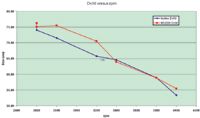
Figure 6: Off- and on-line measurement of particle size as a function of mill rotor speed.
The results show that both analytical methods successfully detect decreasing particle size as the blade speed increases. However, the on-line system gives a smoother correlation that more accurately reflects the expected trend. It exhibits better stability and greater sensitivity, highlighting the benefits of embedded analysis compared with an off-line method. Despite the short run time and the sampling errors introduced by manual analysis, it is possible to demonstrate a very stable correlation between off- and on-line results as shown in Figure 7.
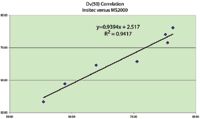
Figure 7: Correlation plot of on-line Dv50 (Insitec) versus off-line Dv50 (Mastersizer 2000). R2 = 0.9417.
Developing successful closed-loop control
A reliable solution for continuous real-time particle-size measurement provided the opportunity to prove the concept of fully automated mill control. Steps were taken to integrate the mill and analyzer and to work toward the goal of full automation. The Insitec computer provides a link between the mill programmable logic controller (PLC) and the on-line particle-size analyzer. A fully integrated system was developed that uses upgraded PLC code and Malvern M.I.M.I.C software to handle data exchange between the main pieces of hardware. The operator interacts with this computer via the mill human–machine interface (HMI) and is able to input set points for the control loop, remotely start and stop the analyzer and mill, perform background tests, and receive particle-size results. Figure 8 shows the integrated system architecture.

Figure 8: Integrated system architecture for the automated mill with on-line particle-size analyzer. OSI PI is an operational event and real-time data-management infrastructure by OSISoft. TCIP/IP is an Internet protocol. M.I.M.I.C is Malvern Instruments Multiple Instruments Control. OPC is object linking and embedding for process control. PSA is particle-size analyzer. PLC is programmable logic controller.
A closed-control loop links particle size with rotor speed. Given a particle size set point and control range, the mill will adjust speed until particle size is brought into the defined range. In initial trials, proportional (P) control only was used and the chosen feedback parameter was average Dv50 (the particle size below which 50% of the distribution lies), with a 30-s rolling average. Even though the system was challenged by deliberately setting rotor speed extremely low and extremely high, the loop brought the process to the required steady state within a window of ± 2 μm in less than 5 min.
In further tests, the set point was reduced from the initial 58 μm to 50 μm and then back up to its original value. During this trial, the system stabilized at the first set point after about 1 min, reached the second set point in about 30 s after the change had been made, and completed the final transition in less than 2 min. These short changeover times highlight the effectiveness of the control system, even in the absence of comprehensive loop tuning.
The trend shown in Figure 9 is from the latter part of this trial when the process had steadied at the final operating condition. In steady state, the control loop is able to keep the particle size in the desired range by varying rotor speed within a ± 200 rpm range.

Figure 9: Steady-state operation of the mill under automated control.
In addition, the trend demonstrates how with real-time measurement, process upsets are detected instantly. At the time highlighted by the green oval, Dv90 spikes while transmission plunges rapidly, indicating some kind of unexpected event. In fact, the product containers overfilled at this point, backing up into the spool piece and forcing the sample probe to work in a densely packed powder bed. Consequently, the concentration of powder flowing into the measurement zone rose and caused a fall in transmission because gas flow was insufficient to break up so much agglomerated material, Dv90 increased. This rapid detection of process upsets is extremely beneficial because it enables the operator to quickly take remedial action, thereby minimizing the production of out–of–specification material.
Finally, it is useful to examine what happens at the end of the run as the mill starts to empty. Transmission becomes high as the amount of powder drawn into the measurement zone starts to fall. Particle size drops because the mill is discharging leftover fines. Eventually the material level drops to near zero and a low-scattering signal is generated by the analyzer. During this final stage, automated control will wind down the speed of the rotor in response to decreasing particle size. The low-scattering signal is used to trigger the mill shutdown sequence.
With full automation, the operator simply selects the target particle size and then feeds material into the mill. Real-time process variable tracking and cumulative batch results are displayed at the mill HMI. Tight control virtually eliminates out-of-specification production and reduces the requirement for in-process testing. If control is sufficiently good, which is feasible with a well-tuned proportional integral derivative (PID) loop, it is possible that product quality will ultimately be assured through on-line testing and allow for real-time release and reduction for the overall cost of quality.
The mill is responsive to variability in the feed, and compensates for it, thus keeping the particle size of the output within the specification at all times. Product consistency is exemplary, with the mill effectively absorbing upstream variability rather than simply passing it on to downstream processing. The history report produced for each batch shows exactly how mill speed has changed to maintain particle size at any point and confirms that the specification is met throughout the process. These real-time data quantify variability in the feed and give insight into upstream operations.
Automated mill control based on real-time particle-size analysis can be applied to many different processes. For existing manufacture, its use is likely to necessitate regulatory approval, but for new products, there is the option of developing on the basis of automated manufacture. Both pilot- and full-scale operation are likely to benefit in the future, the specific benefits being unique to each case.
At the pilot scale, improved product consistency is enormously beneficial because it enhances decision-making processes. It is much easier to correctly quantify the impact of API particle-size distribution on drug-product manufacturability and quality when the particle size is tightly controlled. This milling-control study illustrates one of the reasons why PAT solutions are valuable when the knowledge-based approach encouraged by QbD is adopted. In manufacture, better control translates into first-time-right production, less waste, better equipment utilization, and a reduced requirement for manual input, all of which reduce production and quality costs.
Conclusions
The PAT initiative encourages the pharmaceutical industry to embrace new analytical approaches with the aim of transforming process development and manufacture. Realtime process monitoring and automated control are essential elements of this transformation, which has the potential to improve product quality, cut production costs and reduce time to market.
This case study highlights the availability, relevance, and benefits of a commercially available PAT solution for particle-size analysis. For pharmaceutical products, particle size is often a critical quality attribute that directly impacts performance and/or manufacturability, so better control delivers significant gains. An on-line system was used to transform a stand-alone manual mill into an automated process unit that will integrate into a manufacturing facility with a distributed control system or statistical process control. The Insitec analyzer used is a proven process solution for real-time particle sizing that additionally meets pharmaceutical industry requirements for clean in place, sterilize in place, validation and 21 CFR Part 11, the federal regulations providing guidelines on electronic records and electronic signatures in the United States.
The benefits of automating control include improved product quality, increased throughput, and less waste. Furthermore, automation opens up a route to semicontinuous operation and real-time release, important long-term goals in reaching operational excellence.
Qualification of an automated mill with closed-loop control delivers a solution that could potentially be used elsewhere in the company for both pilot- and full-scale operations. Semicontinuous operation with extended run times is a realistic and attractive alternative to conventional batch operations.
Alon Vaisman* is an application development manager at Malvern Instruments, Enigma Business Park, Grovewood Road, Malvern, Worcestershire, WR14 1XZ, UK, tel: +44 (0)1684 892456, fax +44 (0)1684 892789 alon.vaisman@malvern.com. Yanhui Hu is a principal quality-by-design engineer in the quality assurance division at Abbott Laboratories.
*To whom all correspondence should be addressed.

Drug Solutions Podcast: A Closer Look at mRNA in Oncology and Vaccines
April 30th 2024In this episode fo the Drug Solutions Podcast, etherna’s vice-president of Technology and Innovation, Stefaan De Koker, discusses the merits and challenges of using mRNA as the foundation for therapeutics in oncology as well as for vaccines.
Pharmaceutical Tariffs Are Imminent: How Industry is Bracing for Impact
April 16th 2025On April 14, 2025, the Trump Administration launched a national security-driven investigation into pharmaceuticals, a move that will likely result in tariffs being placed on pharmaceutical drugs, ingredients, and other components that are imported from outside of the United States.